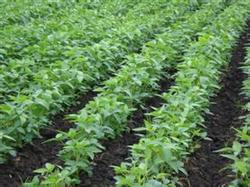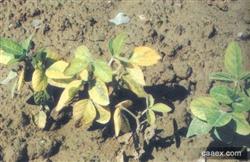Soybean disease control: downy mildew

[distribution and damage] it occurs in all soybean producing areas all over the country, especially in Northeast and North China where the temperature is cold. The disease is caused by fungal infection of Peronosporamanschurica (Naum.) Jyd.etGaum in Northeast China. Generally, the output is reduced by 6%, the price of beans is reduced by 15%, and the damage rate of beans is about 10%. In addition to harming soybeans, they also harm wild soybeans. [symptoms] mainly manifested in leaves and beans. When the first pair of true leaves of the seedlings unfolded, green patches appeared along both sides of the leaf vein, and sometimes the whole leaf turned yellowish, and when the weather was wet, the back of the leaf was densely covered with gray-white downy mildew layer, that is, the cyst peduncle and sporangium of the pathogen. Round or irregular yellow-green disease spots with unclear edges appeared on the surface of the leaves in the adult stage, and the disease spots turned brown in the later stage. There is also a gray-white to grayish-purple downy mildew layer on the disease spot on the back of the leaf. Finally, the leaves dried up and died. There are no obvious symptoms on the surface of the pod. A layer of white mycelium is attached to the surface of the pod, which contains a large number of germ oospores. [incidence regularity] the oospore of the pathogen overwintered on the seed or in the remnant of diseased leaves. In the coming year, oospores germinate and produce zoospores, which invade the growth point through germs, spread to true leaves and buds, and form systematic infection. Subsequently, a large number of sporangia are produced in the disease tissue, which are spread by wind, rain and airflow. After the sporangium germinates and produces the germ tube, it invades the host from the stomata, spreads in the intercellular space, and then forms the sporangium stem and sporangium, so it is re-infected many times. After pod formation, the hyphae in the diseased plant invaded into the pod through the pith of the stem and stalk, causing the disease of the bean grain and forming hyphae and oospores on the bean grain. Is it cold, rainy, dewy and cloudy? Does ⒉≈ Wu share the same purpose as ⌒? [control methods] 1. Select disease-resistant varieties. 2. The diseased seeds were removed by seed treatment, and the seeds were treated with 50% thiram wettable powder with 0.5% seed weight. 3. After chemical control, spray 72% DuPont Kelou wettable powder 800 times liquid, or 1 Vutril 1 Vol 200 Bordeaux solution, or 50% Fumishuang wettable powder 500 times liquid, or 65% Dessen zinc wettable powder 500 times solution spray for 1 time twice.
- Prev

Control measures of soybean diseases
Sclerotinia sclerotiorum mainly infects soybean stems and usually begins to occur in late July. Brown spots appeared on the stems at the early stage of infection, white cotton flocculent mycelium and white particles appeared on the later spots, and then black particles (sclerotia) appeared. Vertical dissection of diseased plant stems, visible black cylindrical rat-like sclerotia, diseased plant dead after...
- Next

Determination and Control of Soybean "Fire Dragon Seedling"
Soybean cyst nematode disease is also called "fire dragon seedling" disease, which is caused by nematode parasitism on soybean roots. The root system of diseased plants is poorly developed, the lateral roots are significantly reduced, the growth is slow, the plants are short, the stems and leaves are yellow, the pods are not full, or the seeds are not set, and even the whole plant dies. Pulling up the diseased plants and observing, we can see that there are many needles on the fine roots...
Related
- The first cup of black tea in spring, the flavor and history of tea gardens in Kenya, Africa
- The computer can not only choose potatoes, but also grow tea rice. AI will grow winter oolong tea champion.
- It is not only the inflated tea bitten by insects, but also engraved with the four seasons tea in Beipu.
- The Oriental Beauty Tea Festival in Zhuxian County takes the stage at the weekend to experience the plus-size feast of oil tea.
- & quot; Oriental Beauty Tea & Exploration of Emei in Hsinchu, the hometown of quot;
- The new variety of strawberry "Tainong 1" dessert is the first choice with mellow aroma. Crimson gorgeous
- History of Tea in Taiwan: from Wild Inner Mountain to Export Tea Garden
- Two types of Taiwan Oriental Beauty Black Tea won the British three-Star Award for Childhood Tea Xiang Zhang Jiaqi changed from pilot to champion tea maker.
- Banana species and varieties: the planting history of Taiwan Xianren banana and dwarf banana is long, is banana disease resistant?
- Coffee planting Technology: Qianjie Coffee from Seedling to harvesting

